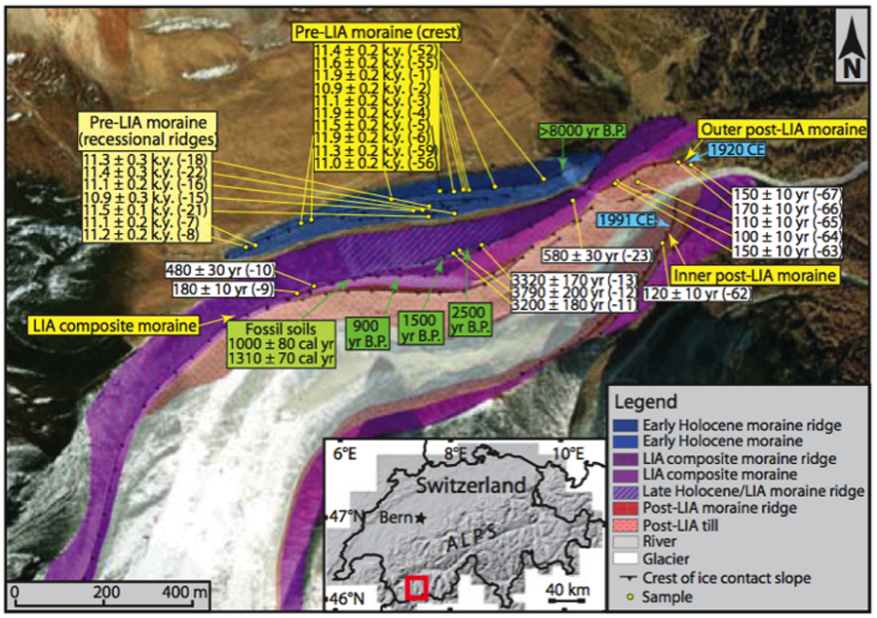Not surprisingly significant changes in climate leave their imprint on the landscape. During the last glacial maximum, ~20,000 years ago ice more than a mile thick covered vast portions of the continents.
When a glacier retreats due to warmer or drier climate, it may expose boulders and fresh bedrock surfaces to cosmic rays entering earth's atmosphere from space. These newly exposed surfaces are often eroded by glacial scouring and erosion and as such their cosmogenic clock has been restarted. Interaction between the cosmic rays and the oxygen in minerals in the rock creates new isotopes such as 10Be, which then begin to accumulate in the minerals. Measurement of the amount of 10Be accumulated dates the time the rock was exposed by the ice retreat. Similar production systematics exist for in situ production of 14C, 26Al, 36Cl. Pairs of cosmogenic isotopes with different half-lives and production rates (e.g., 10Be, 26Al) can be used to determine long-term erosion rates. Advances in field sampling, better prediction of 10Be production rates, sample chemistry, and AMS analysis over the last five years have enabled the measurement at CAMS of boulder surfaces that were exposed only in the last several decades. This cutting edge analytical work allows us to explore the intersection of climate change and geomorphology on near instrumental timescales, e.g., understanding the glacial advances and retreats during the Little Ice Age which ended ~150 years ago. In the example shown below, the CAMS high-precision 10Be capability shows the history of the Tsidjiore Nuove glacier in the Swiss Alps since the beginning of the Holocene epoch, with cold glacial conditions recorded at the end of the last glacial period (~11,400 years ago), at 3800 years ago, and during the Little Ice Age (LIA), between 500 and 170 years ago.
Schimmelpfennig et al. (2012), "Holocene glacier culminations in the Western Alps and their hemispheric relevance." Geology, 40, 891-894.
A related application of cosmogenic chemistry is the use of 'meteoric 10Be.' This form of 10Be, also a cosmogenic isotope, is primarly formed by the interaction of cosmic rays with oxygen and nitrogen in the stratosphere and high troposphere. The 10Be adheres to particles and/or washes out in precipitation, in addition to dry deposition and accumulates on the landscape. From ice-cores which can have well quantified age models and ice accumulation histories, we can reconstruct the 10Be production rate ![]() . If one knows the rate of production of 10Be, then the accumulation of meteoric 10Be in soils, sediments, and on the landscape can provide inferences on the accumulation history of soil/sediment (ie., gain/loss). The accumulation of soil/sediment can then be related to climatic factors such as P/E and landscape evolution.
. If one knows the rate of production of 10Be, then the accumulation of meteoric 10Be in soils, sediments, and on the landscape can provide inferences on the accumulation history of soil/sediment (ie., gain/loss). The accumulation of soil/sediment can then be related to climatic factors such as P/E and landscape evolution.





